To excel in drone racing, you need advanced techniques that enhance your speed and control. Focus on throttle management, making gradual adjustments for stability while utilizing throttle curves for smoother maneuvers. Master dynamic yaw control to navigate corners effectively, and apply pylon racing techniques for swift turns. Improve your situational awareness by practicing peripheral vision and quick decision-making drills, which will help you anticipate obstacles. Optimizing your racing line and analyzing race footage helps refine your strategy. Tuning your drone's settings can also greatly impact performance. Keep exploring these methods to activate your full racing potential.
Advanced Control Techniques
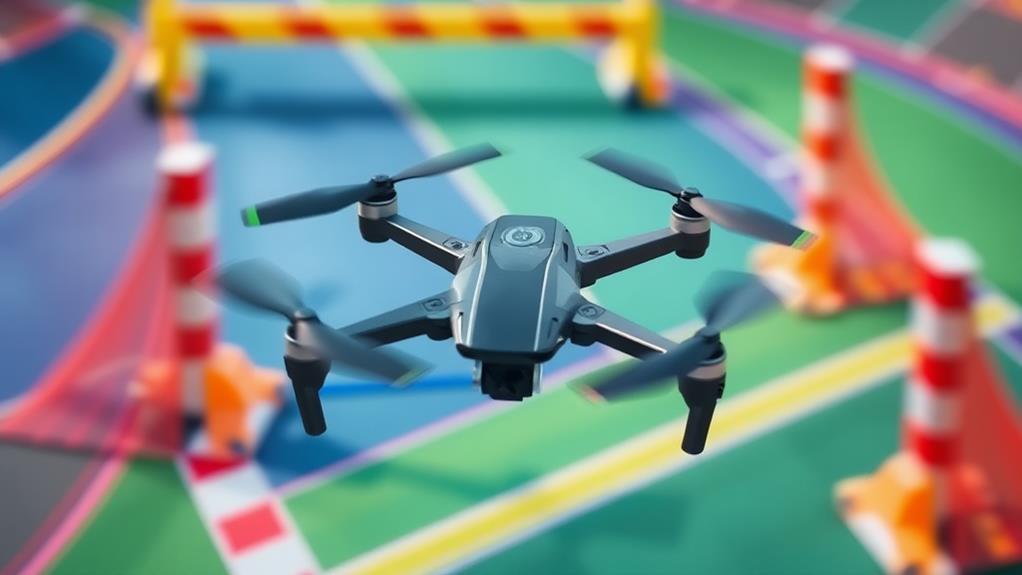
Mastering advanced control techniques is essential for any serious drone racer looking to gain a competitive edge. One of the most important skills is throttle control. By managing your throttle precisely, you can maintain peak speed during turns, minimizing altitude loss and enhancing cornering efficiency.
Additionally, dynamic yaw control is critical; mastering yaw adjustments allows you to execute sharper turns and maintain a faster trajectory through gates and around obstacles. Practicing effectively in open spaces while gradually introducing challenges can greatly improve your control skills beginner-friendly models as you develop your racing techniques.
Incorporating pylon racing techniques can further enhance your performance. For example, employing "pylon turns," where you approach a turn at an angle and use throttle bursts to pivot around the pylon, can greatly reduce the time spent in each turn.
Flight path enhancement is another essential aspect. Analyzing the race course helps you select the most efficient paths, combining straight-line flying with strategic turns to shave off valuable seconds.
Utilizing FPV goggles with real-time feedback can elevate your racing experience. The telemetry data provides insights on battery life, signal strength, and speed, empowering you to make informed decisions throughout the race.
Racing Line Optimization
When it comes to drone racing, optimizing your racing line can make a significant difference in your lap times. Racing line optimization involves finding the most efficient path through the track, which minimizes distance while maximizing speed.
One key technique is apexing corners, meaning you hit the inside edge of a turn at just the right moment. This helps maintain momentum and reduces your overall lap time. Mastering advanced maneuvers like the Power Turn can further enhance your racing line efficiency by allowing for sharper direction changes.
Different corners require different strategies; sometimes early apexing is beneficial, while other times late apexing is the way to go. This combination allows for smoother shifts between turns, which is essential for keeping your speed up.
Using simulation tools can be incredibly helpful for visualizing and practicing your ideal racing line before race day. These tools enable you to refine your approach and enhance your decision-making skills during high-speed conditions.
Additionally, observing professional racers can provide valuable insights. By analyzing their racing lines, you can learn effective techniques for traversing complex circuits.
Pay attention to how they handle corners; it could be the key to improving your performance on the track.
Throttle Management Strategies
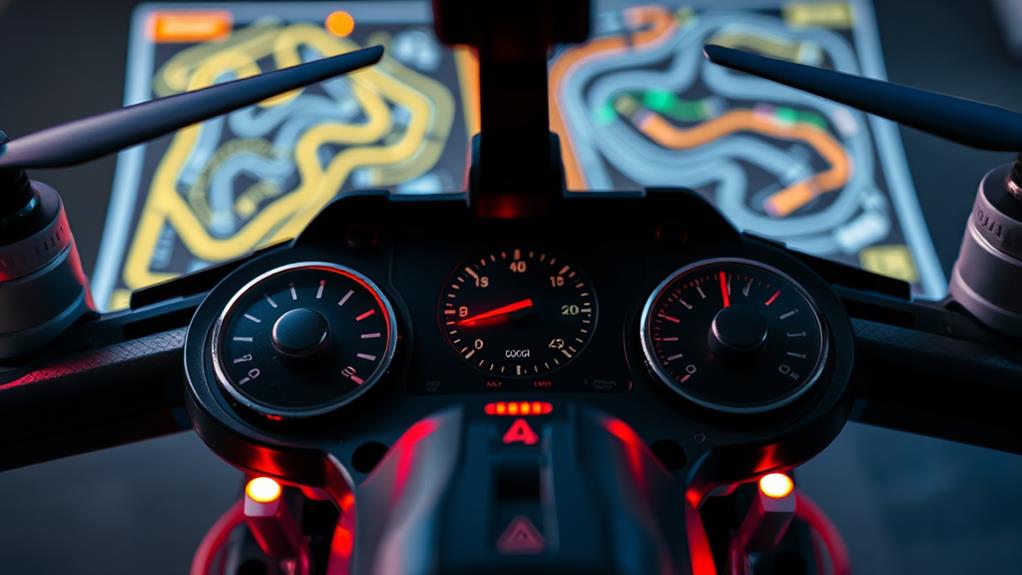
Throttle management is essential for maintaining speed and control during drone racing, as it allows you to navigate turns and obstacles with precision. Effective throttle adjustments can mean the difference between a smooth flight and a crash. To improve your racing drones' performance, practice gradual throttle adjustments when accelerating or decelerating. Sudden movements can destabilize your drone, so smooth changes are key.
Additionally, integrating 5G connectivity can enhance real-time communication, allowing for even better throttle management through reduced latency in your controls.
Utilizing a throttle curve is another advanced technique that can help you achieve smoother throttle management. This approach enables better control during complex maneuvers like tight turns and rapid descents. Understanding the relationship between throttle input and pitch angle is also significant. By fine-tuning this response, you enhance your drone's overall handling, allowing for ideal speed while maintaining stability.
Additionally, regularly analyzing your throttle usage data during practice can reveal patterns that inform your strategies. By identifying what works best for your racing style, you can refine your throttle management for competitive scenarios. Incorporating these strategies won't only improve your precision but also your overall racing performance.
Mastering throttle management is a fundamental step towards becoming a successful drone racer.
Dynamic Yaw Control
Effective throttle management sets the stage for mastering dynamic yaw control, which plays a pivotal role in enhancing your drone's agility during races. This technique involves real-time adjustments to the yaw axis, allowing for sharper turns and better navigation through tight corners.
To harness the full potential of dynamic yaw control, consider these key points:
- Tuning Settings: Use your flight controller's settings to adjust yaw rates, tailoring them to your racing environment and personal style.
- Coordination is Key: Mastering dynamic yaw control requires simultaneous adjustments of throttle and pitch, demanding high levels of coordination and spatial awareness.
- Practice Makes Perfect: Regular practice leads to a more instinctive flying style, helping you react swiftly to obstacles and course changes.
- Reduce Lap Times: Efficient use of dynamic yaw can considerably cut down your lap times in competitive settings, giving you an edge over opponents.
Situational Awareness Enhancement
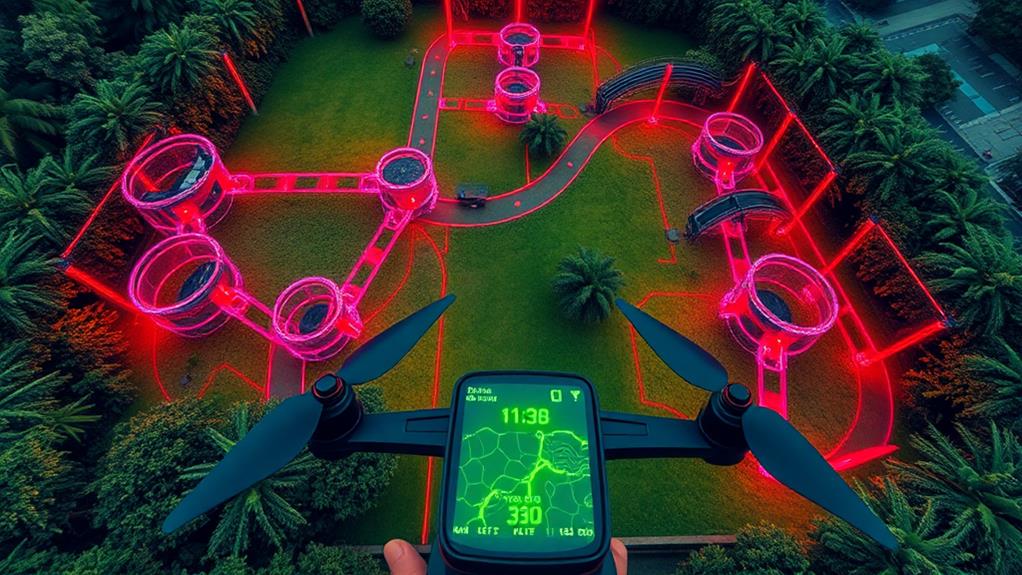
In drone racing, sharpening your situational awareness is essential for success.
You'll want to train your peripheral vision to spot obstacles and competitors while making quick decisions during high-speed maneuvers.
Peripheral Vision Training
While you might focus intently on the FPV feed during a race, developing your peripheral vision is vital for enhancing situational awareness.
This skill helps you detect obstacles and other drones outside your direct line of sight, important for maneuvering through complex racing circuits.
By improving your peripheral vision, you can enhance your reaction times and decision-making during high-speed maneuvers.
Here are some effective training drills:
- Object Tracking: Practice following multiple objects simultaneously to strengthen your peripheral vision and anticipate potential collisions.
- Visual Cues: Use colored markers or flags around your training area to help your brain recognize important spatial information without losing focus on the FPV view.
- Quick Glance Drills: Regularly incorporate drills that require you to take quick glances to the sides while flying, helping maintain situational awareness throughout a race.
- Obstacle Courses: Set up courses that challenge your ability to maneuver while keeping an eye on your surroundings, reinforcing the connection between peripheral vision and obstacle detection.
Quick Decision Making
Mastering quick decision-making during drone racing hinges on your ability to stay aware of your surroundings and react swiftly to changing situations. Developing situational awareness involves constantly monitoring your drone's position, speed, and the obstacles around you.
By practicing in varied environments, like tight indoor spaces and obstacle courses, you can simulate real racing conditions that demand fast reactions.
FPV simulators are invaluable tools for honing your decision-making skills. They allow you to experience diverse scenarios and learn to respond quickly without the risk of damaging your physical drone.
Additionally, regularly analyzing race footage is essential; it helps you identify areas needing improvement and adapt your strategies for future races.
Engaging with experienced racers and participating in community discussions can also enhance your situational awareness. These interactions provide insights into effective techniques and quick decision-making strategies that seasoned FPV pilots employ.
Environmental Awareness Skills
Enhancing your environmental awareness skills is essential for excelling in drone racing. When you're out flying, having a keen sense of your surroundings can make all the difference. Here are some important tips to boost your situational awareness:
- Understand Terrain: Familiarize yourself with elevation changes, tree lines, and building layouts. This enhances your spatial awareness, allowing you to navigate effectively during races.
- Monitor Weather Conditions: Keep an eye on wind speed, direction, and precipitation. Adapting your flying strategy based on these factors is critical, as they greatly impact drone performance and stability.
- Practice Obstacle Recognition: Train yourself to quickly spot potential hazards, like other racers or obstacles. This skill is essential for making timely evasive maneuvers during high-speed racing.
- Strategic Pilot Positioning: Position yourself in a way that maintains a clear line of sight to minimize blind spots. This guarantees better control and quicker reaction times, fundamental for dominating the racing circuit.
Advanced Flight Modes
When you race drones, mastering advanced flight modes can greatly enhance your performance.
Modes like Acro and Race Mode give you precision control over your maneuvers, allowing for complex tricks and quick responses on tight courses.
Meanwhile, options like Altitude Hold and GPS Mode guarantee you can focus on speed and navigation without sacrificing safety or altitude management.
Precision Control Techniques
Precision control techniques are essential for drone racing, allowing you to steer through complex circuits with unmatched accuracy. Mastering these advanced techniques can greatly elevate your racing skills.
- Throttle Control: This is critical for managing altitude during high-speed maneuvers, enabling you to execute sharp turns without losing stability.
- Yaw, Pitch, and Roll: Understanding these axes helps you maintain control while steering through tight turns and quick direction changes, enhancing your overall performance.
- Orientation Awareness: This skill prevents disorientation during high-speed flights, ensuring you can swiftly adapt to changing environments and obstacles.
- Controlled Ascent and Descent: Gradual throttle adjustments are key to maintaining smooth flight paths, which is essential when steering through tight spaces and around obstacles.
To refine your precision control, engaging in FPV Simulator Practice is highly beneficial. It allows you to hone your skills in a risk-free environment, improving your muscle memory and confidence for real-world racing scenarios.
Advanced Maneuvering Strategies
Mastering advanced maneuvering strategies can considerably improve your performance in drone racing. One key technique is the Power Loop, where you execute a vertical loop while maintaining forward momentum. This requires precise control of throttle and pitch to guarantee a smooth changeover.
The Split-S is another agile maneuver; it involves a half-loop followed by a roll, enabling rapid directional changes while keeping high speed.
The Reverse Knife Edge is an advanced technique that demands exceptional control. You fly the drone on its side while moving in reverse, which challenges your roll, yaw, and throttle management.
For a fascinating display, try the 360° Yaw Spin. This maneuver rapidly rotates your drone around its vertical axis, adding dynamic visuals to your routine.
Lastly, the Juicy Cartwheel combines graceful cartwheel motions with agility, showcasing your FPV skills while enhancing aerial displays.
Incorporating these advanced techniques into your flying not only elevates your racing capabilities but also impresses spectators. Practice these maneuvers consistently to refine your control and enhance your overall drone racing experience. Embrace these strategies, and you'll be well on your way to dominating the racecourse.
Predictive Flying Skills
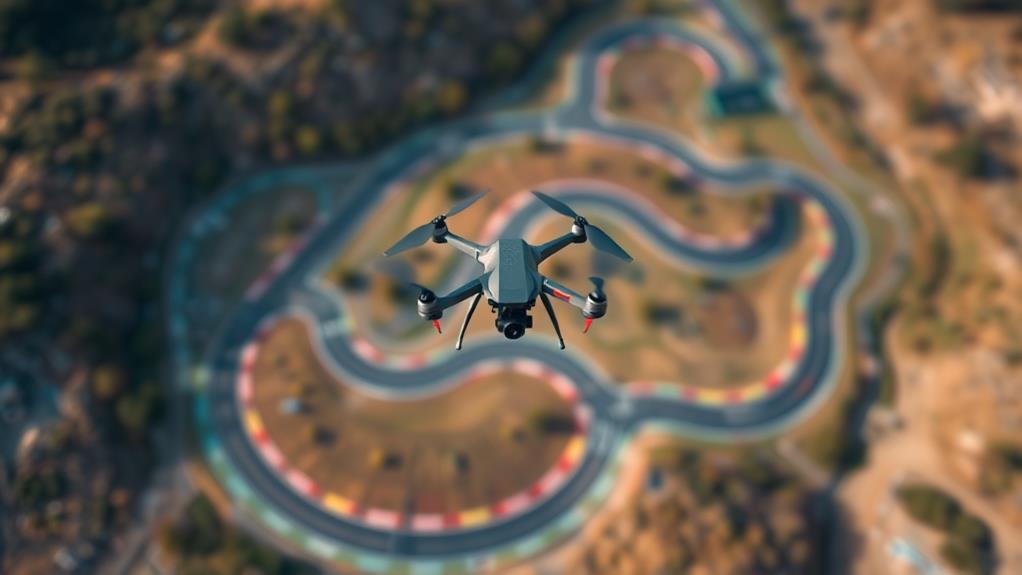
Harnessing predictive flying skills is essential for any successful drone racer. These skills enable you to stay ahead of the competition by anticipating changes in the racing environment. Here are four key components to enhance your predictive flying abilities:
- Situational Awareness: Keep a keen eye on your drone's position relative to obstacles and the racing line. This awareness helps you react swiftly to any changes.
- Understanding Flight Dynamics: Familiarize yourself with how wind, throttle input, and drone weight affect your flight. This knowledge allows you to predict how your drone will respond during fast maneuvers.
- Visual Tracking: Practice focusing on your target path while scanning for obstacles. This dual focus sharpens your ability to adapt to changes in the course layout.
- Anticipation of Turns: Master the art of predicting the best trajectory and entry speed for turns. This skill can drastically reduce your lap times and improve overall performance.
Incorporating data analysis into your training can further refine your understanding of the most efficient racing lines.
Circuit Navigation Strategies
Building on your predictive flying skills, effective circuit maneuvering strategies are essential to maximizing your performance during drone races. Memorizing the track layout allows you to anticipate turns and obstacles, potentially reducing your lap times by up to 10% as you refine your racing line.
Always aim for the best racing line, which represents the shortest and fastest path around the circuit. Throttle management becomes vital during turns; proper acceleration helps prevent overshooting corners, allowing you to maintain momentum necessary for speed.
Learning to gauge the ideal angle for each turn enhances your cornering efficiency. Small adjustments can greatly reduce drag and improve stability, especially in tighter sections of the track.
You should also consider advanced techniques like power slides for sharp turns. This approach lets you maintain speed while maneuvering around obstacles, helping you exit corners faster without losing control.
Combine these strategies, and you'll find yourself not just competing, but excelling in drone races. Remember, effective circuit maneuvering is about mastering the balance of speed, control, and precision.
Tuning and Customization Tips
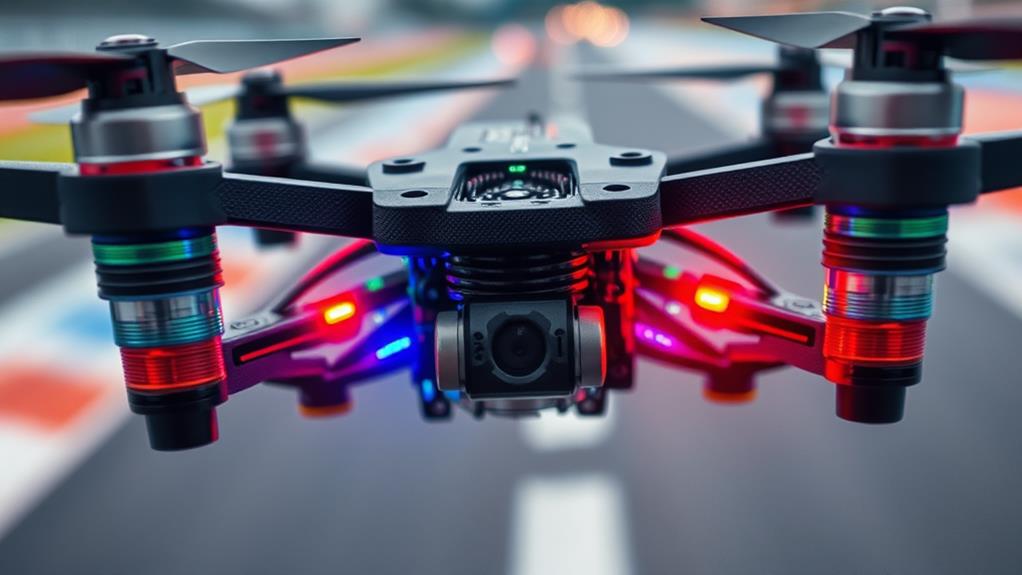
When you fine-tune your drone, the right adjustments can make a world of difference in your racing performance. Proper tuning and customization can help you achieve ideal control and speed during FPV racing.
Here are some essential tips to take into account:
- Tune the Proportional (PID) Settings: Adjusting PID settings enhances responsiveness and stability, vital during high-speed maneuvers.
- Optimize Weight Distribution: By customizing the placement of components like the battery and camera, you can improve your drone's center of gravity, allowing for quicker turns and better handling.
- Upgrade Electronic Speed Controllers (ESCs): High-quality ESCs with fast refresh rates will offer smoother throttle response, helping you adjust speed rapidly during races.
- Experiment with Flight Modes: Switching between acro and angle modes can adapt your control experience, enabling you to maintain a steady flight tailored to different racing environments.
Conclusion
In summary, mastering advanced techniques in drone racing can greatly enhance your performance on the track. Did you know that top racers can achieve speeds over 100 mph while maneuvering through complex courses? By focusing on control techniques, throttle management, and circuit navigation, you can refine your skills and stay competitive. Embrace these strategies, stay aware of your surroundings, and continually tune your drone for peak performance. The sky's the limit when you apply these advanced methods!
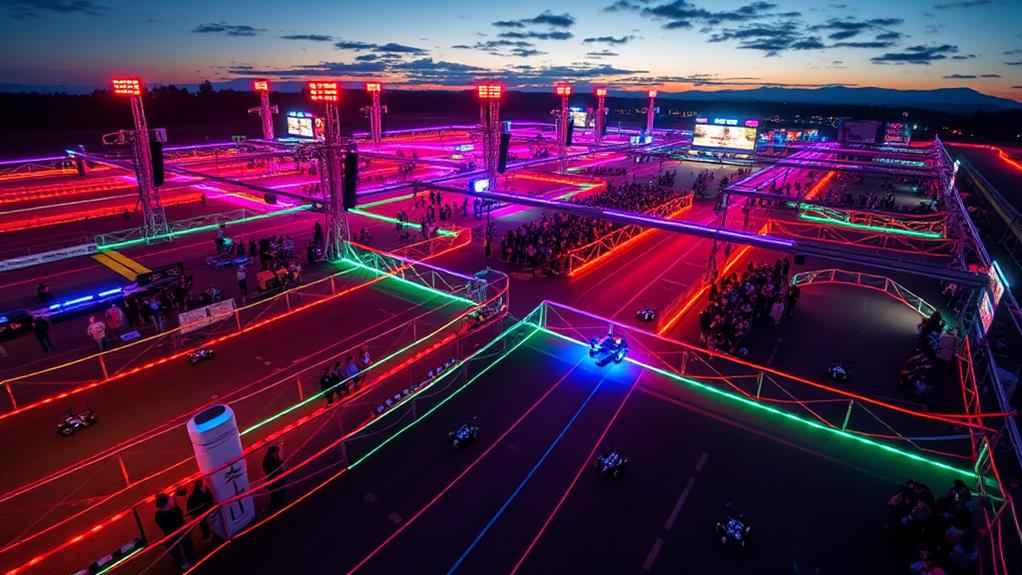
Leave a Reply